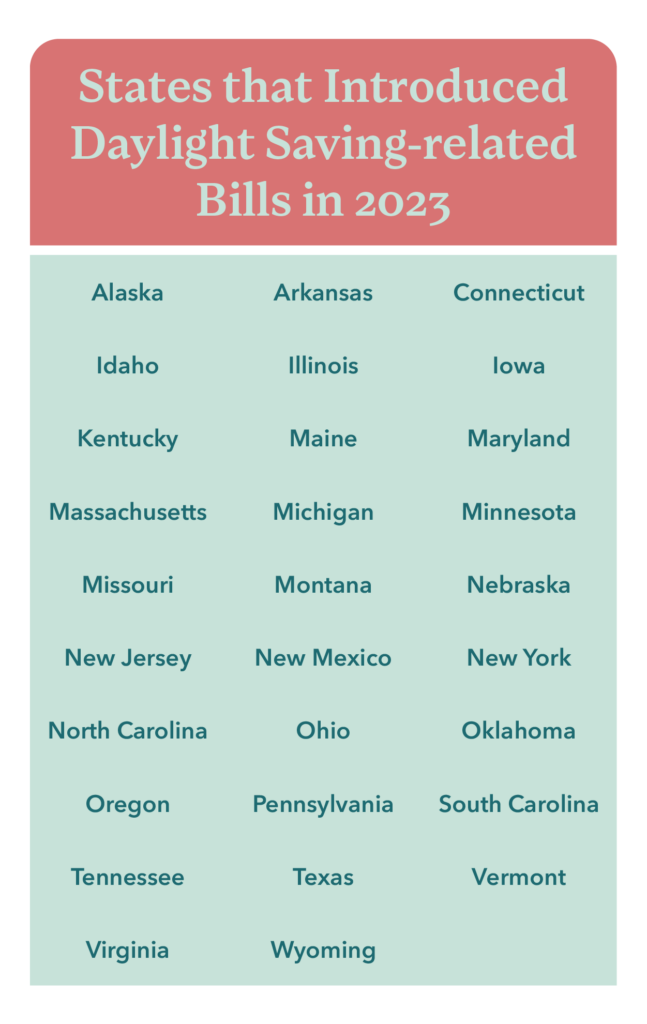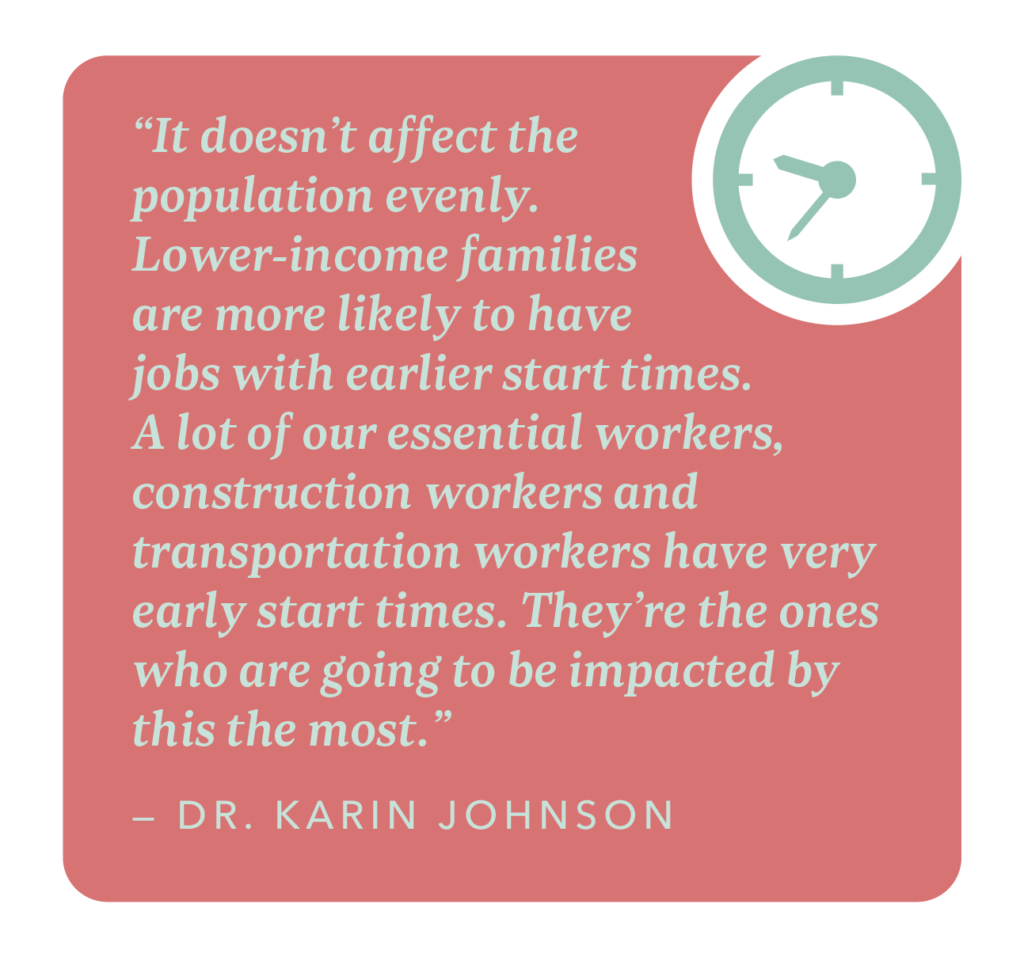
By Trey Delida
Twice each year we adjust our clocks to “fall backward” and “spring forward.” There was major momentum toward a national switch in 2022, which would eliminate daylight saving time across the country, but that push was ultimately stalled before getting approval from the House.
Over half of the American population, 63%, favor eliminating seasonal time changes, according to the American Academy of Sleep Medicine. The issue has been a point of contention in state houses for years, even reaching the federal level with no resolution.
Let’s start from the beginning.
The creation of daylight saving time, or DST, is often credited to New Zealand entomologist George Vernon Hudson, whose proposal of the idea is recorded in a newspaper from 1895. What we know for certain is that the seasonal time change was officially adopted during World War I as an international effort to conserve energy.
The United States has a complicated history with daylight saving time. Since its inception, DST has been through many iterations, including reinstatement, undoing and extending daylight saving months, and even getting renamed in 1942 during World War II under President Franklin Roosevelt as “war time.”
Once adopted by many at the state level, daylight saving time was standardized via the Uniform Time Act in 1966.
Though often overlooked, the U.S. did enact a “permanent” daylight saving schedule in the 1970s, but its favorability quickly took a turn for the worse. To reduce energy consumption, Congress passed a law that would have made daylight saving time permanent for two years.
However, they eventually voted to undo the change just 10 months in due to many areas of the country experiencing sunrise at 8:30 a.m. or later and general discontent from the public. Fast forward nearly 50 years, U.S. Sen. Marco Rubio of Florida introduced the Sunshine Protection Act in 2018, aiming to ditch the biannual changing of the clocks and opt for another go at permanent daylight saving time. It garnered support from then President Donald Trump, but ultimately failed. It was reintroduced in 2019 by U.S. Rep. Vern Buchanan and failed again.

In March 2022, the Senate ultimately passed the reintroduced Sunshine Protection Act with unanimous approval through an expedited process. However, the bill failed to be taken up in the House. Members cited higher priorities, like a budget deficit and war in Ukraine, but there was also a growing chorus of criticism about the bill’s approach
States have resounded this desire to resolve the changing clock. Over the past few years, there has been a resurgence in daylight saving-related bills across the country. In 2023 alone, legislation related to daylight saving time was considered by 29 states.
In Colorado, Gov. Jared Polis signed HB 22-1297, the Daylight Saving Time Year Round bill, into law contingent on two big factors.
First, the federal government must enact a law allowing states to decide whether they want to be on permanent daylight saving time or permanent standard time. Second, four other states in the Mountain time zone must opt-in to a permanent daylight saving time model. According to Colorado Sen. Jeff Bridges, who was among the bill’s sponsors, the second factor presents a unique set of challenges for it to pass.
“Folks don’t want to be [among the few states with] a different clock than everybody else,” Bridges said. “The people who were probably the most concerned about our switch to a year-round standard or year-round daylight saving time were the airlines because the Denver International Airport is a huge hub.”
As the third-busiest airport in the U.S., the Denver International Airport is a driving force for Colorado’s economy, generating $36.4 billion in
annual economic impact. Moving to permanent DST without the support of other states could cause significant challenges with flight schedules, potentially driving away revenue. Issues like this arise in every state considering a major shift in time, and the ripple effect of these bills is evident and can be felt across several industries.
Standing alone in a permanent switch to daylight or standard time is rare, though not unheard of. Hawaii and part of Arizona — excluding Navajo Nation territory — operate on a permanent year-round standard time clock. The same circumstances also apply to U.S. territories, including American Samoa, Guam, the Northern Mariana Islands, Puerto Rico and the Virgin Islands.
States can exclude themselves from switching the clocks by opting into a year-round standard-time model, but enacting permanent DST requires the backing of Congress.
“To go to year-round daylight time requires an act of Congress,” Bridges said. “I believe almost all of the states in the Mountain time zone have said that if Congress lets them, they will go to year-round daylight time. The reality is that people just want the madness to end one way or the another.”
It’s true; the overwhelming majority of American citizens just want seasonal time changes to end.
“Only 25% like the existing state of affairs in most of the country, shifting back and forth between daylight saving time in the summer and standard time in the winter,” according to a study from the AP-NORC Center for Public Affairs Research.
While many believe DST is the solution, several states have introduced legislation advocating for a permanent switch to standard time. As of September 2023, Massachusetts, Maine, Minnesota, New York, Oklahoma, Pennsylvania, South Carolina, Tennessee and Vermont considered permanent standard time bills.
In Massachusetts, Sen. Patrick O’Connor authored a petition, accompanied by a bill, to establish permanent standard time within the state to “promote sleep and health.” Studies have linked time changes to several health risks, including heart disease, obesity, strokes, mood disturbances, anxiety and more.
“Massachusetts has been a leader in the past on so many other issues,” O’Connor said. “When it comes to the litany of things from health benefits to potential energy conservations, to public safety, to consistency, all those things spoke to me that permanent standard time was the way forward.”
O’Connor also noted that the movement for daylight saving has a leg up with popularity and name recognition, but he believes that educating the public on standard time is key.
“I think that the benefits outweigh the risks associated with daylight saving time so greatly that — as long as there was a public awareness and education campaign — people would understand it,” O’Connor said. “I don’t think a lot of people know what the medical community is saying about what this does to the body’s rhythm, and I think that we need to have a long, honest conversation about why we’re doing what we’re doing.”
On either side of this debate, some businesses and industries are more susceptible to an indefinite switch than others. Golf courses, shopping centers and convenience stores have long advocated for daylight saving time under the assertion that the extra hour of sunlight promotes their businesses respectively. Scientists and sleep experts advocate for standard time, citing its alignment with the natural functions, circadian rhythms and sleep schedules of the human body.
Similarly, data on depression, productivity, decreases or increases in crime, and reports of traffic fatalities are used bilaterally for the case against both standard time and daylight saving time. However, according to Dr. Karin Johnson, these arguments are most directly linked to the time change itself rather than the long-term effects of a lasting switch.

“The data that is being used to support these claims is data on the time change itself. What they didn’t factor in is what the long-term effects of being on one time versus another,” Johnson said. “Basically, all of the mental health data says that if we can align our bodies more to the sun and not have a circadian rhythm misbalance, we will be better off mental health-wise.”
Johnson is a professor of neurology at UMass Chan Medical School-Baystate and medical director of the Baystate Health Regional Sleep Program in Springfield, Massachusetts. She is also the vice president of Save Standard Time, a nonpartisan, nonprofit effort to preserve the observation of standard time. As a sleep medicine doctor, Johnson’s biggest concern with permanent DST is the belated sunrise and sunsets.
“The standard time zones were defined by the meridian of the time zone to have the sun overhead at noon with a 30-minute difference for the eastern and western edges. Under daylight saving time, that shifts by an hour,” Johnson said. “Our body clocks stay aligned to the sun. When you check cortisol levels and other hormonal levels that tell us where our body clocks are running, they change by about two minutes months after the hour switch.”
For those on the Western edge, where the sun already rises and sets later, year-round DST could result in less sleep and an increase in social jetlag. It is also crucial to note the structural disparities of sunlight and sunset for communities across time zones and socioeconomic status.
“It doesn’t affect the population evenly,” Johnson said. “Lower-income families are more likely to have jobs with earlier start times. A lot of our essential workers, construction workers and transportation workers have very early start times. They’re the ones who are going to be impacted by this the most.”
Navigating this polarizing, multi-layered discussion is difficult. The influence of time is not to be undermined, finding a way forward that mitigates any negative outcomes has proven to be a challenge.
Recent data shows that 40% of Americans prefer year-round standard time while 31% prefer year-round daylight saving time, leaving 28% that would prefer to continue the current biannual switch. Though many of the bills relating to time change have been deferred or await federal approval, the evidence is clear: people want a permanent change.
As the clock ticks on, the fate of seasonal time changes or which time the country will formally adopt is still unclear.


